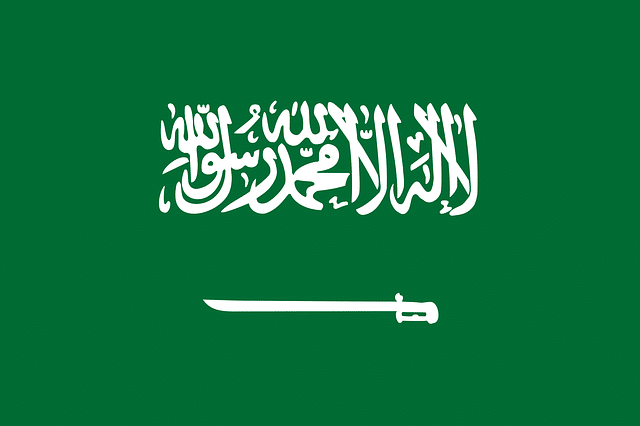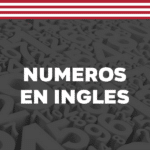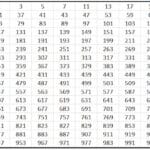The Arabic language is listed as one of the most difficult languages to learn, yet understanding numbers is very simple. Arabic is the official and co-official language from twenty-six countries, and is spoken by more than 420 million of people.
The structure of writing these numbers in Arabic makes more sense than in Spanish. That is why their learning may not be so difficult for you. Something interesting that you should know is that Arabic numerals, or Indo-Arabic numerals, come from the India, hundreds of years ago.
Over time they spread throughout the rest of the Arab countries, and later throughout the world. Today the Arabic numeral system is the one used because it is more easy than the rest. This is a positional numbering system that includes: 0, 1, 2, 3, 4, 5, 6, 7, 8 and 9.
There are Arabs who write numbers like this, and there are others who don't. They use Arabic numbers, which we will show you later. It is important that you learn the other way of writing. It is not fully used in Arab countries, but it does not hurt to be prepared.
In this article we will show you the Cardinal and ordinal numbers. With that it will be enough for you to master the language a little more. In the end we will leave you some examples useful for you to review what you have learned.
Cardinal numbers in Arabic
The cardinal numbers in Arabic, those that are used to count, you must learn from the 0 al 20 from memory.
To form more numbers, as with other languages, you are going to make a composition between the ones and tens.
Arabic numbers from 0 to 20
We are going to present these first numbers to you in the format: number - number in Arabic (digits) - pronunciation - number in Arabic (letters).
- 0 - ٠ - sifr - صِفْرٌ
- 1 - ١ - wahid - واحد
- 2 - ٢ - ithnan - إثنان
- 3 - ٣ - thalatha - ثلاثة
- 4 - ٤ - arba'a - أربع
- 5 - ٥ - khamsa - خمسة
- 6 - ٦ - sitta - ستة
- 7 - ٧ - sab'a - سبعة
- 8 - ٨ - thamaniya - ثمانية
- 9 - ٩ - tis'a - تسعة
- 10 - ١٠ - 'ashra - عشرة
- 11 - ١١ - ahada 'ashar - احد عشر
- 12 - ١٢ - ithna 'ashar - اثنا عشر
- 13 - ١٣ - thalatha 'ashar - ثلاثة عشر
- 14 - ١٤ - arba'a 'ashar - اربعة عشر
- 15 - ١٥ - khamsa 'ashar - خمسة عشر
- 16 - ١٦ - sitta 'ashar - ستة عشر
- 17 - ١٧ - sab'a 'ashar - سبعة عشر
- 18 - ١٨ - thamaniya 'ashar - ثمانية عشر
- 19 - ١٩ - tis'a 'ashar - تسعة عشر
- 20 - ٢٠ - 'ishrun - عشرون
Digit numbers in Arabic are a bit like the conventional ones: ٠, ١, ٢, ٣, ٤, ٥, ٦, ٧, ٨ and ٩.
And the writing, to represent more numbers, is the same. For example, the number 21 is written "٢١". So it is with the rest.
Explaining the way they are written (عشرون) is more complicated. That is why we are only going to show you already written, without explaining how to do it.
The first twenty one numbers, 0 to 20, they have unique names. Memorize them. There are also others with their own names that you will see.
The rest are combinations between tens and ones, at least that's how it happens until 99.
Look at all the tens in Arabic:
- 10 - ١٠ - 'ashra - عشرة
- 20 - ٢٠ - 'ishrun - عشرون
- 30 - ٣٠ ―thalathun - ثلاثون
- 40 - ٤٠ - arba'un - أربعون
- 50 - ٥٠ - khamsun - خمسون
- 60 - ٦٠ - sittun - ستون
- 70 - ٧٠ - sab'un - سبعون
- 80 - ٨٠ - thamanun - ثمانون
- 90 - ٩٠ - tis'un - تسعون
Notice that from the second ten they are the same units ending in «a», with their exceptions. This is the way you should pronounce them.
To write numbers within the tens range, after 20, you must use the connector "Wa" (و). And put the unit first and then the ten.
For example, thirty-three would look like: three thirty in Arabic.
Look at how the numbers 20 to 29 are written.
- 21 - ٢١ - wahid wa-'ishroun - واحد وعشرون
- 22 - ٢٢ - isnan wa-'ishroun - إثنان وعشرون
- 23 - ٢٣ - Salasah wa-'ishroun - ثلاثة وعشرين
- 24 - ٢٤ - arbah'ah wa-'ishroun - أربع وعشرين
- 25 - ٢٥ - hamsah wa-'ishroun - خمسة وعشرين
- 26 - ٢٦ - sittah wa-'ishroun - ستة وعشرين
- 27 - ٢٧ - sab'ah wa-'ishroun - سبعة وعشرون
- 28 - ٢٨ - samaniyah wa-'ishroun - ثمانية وعشرين
- 29 - ٢٩ - tis'ah wa-'ishroun - تسعة وعشرون
You must keep this same pattern for the rest of the numbers under 99. Next we will show you a list with the rest of the numbers from 30 to 99 in Arabic.
From 30 to 39.
- 30 - ثلاثون
- 31 - واحد وثلاثون
- 32 - اثنان وثلاثون
- 33 - ثلاثة وثلاثون
- 34 - أربعة وثلاثون
- 35 - خمسة وثلاثون
- 36 - ستة وثلاثون
- 37 - سبعة وثلاثون
- 38 - ثمانية وثلاثون
- 39 - تسعة وثلاثون
From 40 to 49.
- 40 - أربعون
- 41 - واحد وأربعون
- 42 - اثنان واربعون
- 43 - ثلاثة وأربعون
- 44 - أربعة وأربعون
- 45 - خمسة وأربعون
- 46 - ستة وأربعون
- 47 - سبعة واربعون
- 48 - ثمانية واربعون
- 49 - تسعة وأربعون
From 50 to 59.
- 50 - خمسون
- 51 - واحد وخمسون
- 52 - اثنان وخمسون
- 53 - ثلاثة وخمسون
- 54 - الرابعة والخمسون
- 55 - خمسة وخمسون
- 56 - ستة وخمسون
- 57 - سبعة وخمسون
- 58 - ثمانية وخمسون
- 59 - تسعة وخمسون
From 60 to 69.
- 60 - ستون
- 61 - واحد وستون
- 62 - اثنان وستون
- 63 - ثلاثة وستون
- 64 - أربعة وستون
- 65 - خمسة وستون
- 66 - ستة وستون
- 67 - سبعة وستون
- 68 - ثمانية وستون
- 69 - تسعة وستون
From 70 to 79.
- 70 - سبعون
- 71 - واحد وسبعون
- 72 - اثنان وسبعون
- 73 - ثلاثة وسبعون
- 74 - أربعة وسبعون
- 75 - خمسة وسبعون
- 76 - ستة وسبعون
- 77 - سبعة وسبعون
- 78 - ثمانية وسبعون
- 79 - تسعة وسبعون
From 80 to 89.
- 80 - ثمانون
- 81 - واحد وثمانون
- 82 - اثنان وثمانون
- 83 - ثلاثة وثمانون
- 84 - أربعة وثمانون
- 85 - خمسة وثمانون
- 86 - ستة وثمانون
- 87 - سبعة وثمانون
- 88 - ثمانية وثمانون
- 89 - تسعة وثمانون
From 90 to 99.
- 90 - تسعين
- 91 - واحد وتسعون
- 92 - اثنان وتسعون
- 93 - ثلاثة وتسعون
- 94 - أربعة وتسعون
- 95 - خمسة وتسعون
- 96 - ستة وتسعون
- 97 - سبعة وتسعون
- 98 - ثمانية وتسعون
- 99 - تسعة وتسعون
Now the rest of the larger numbers are missing, such as hundreds and thousands.
- 100 - miaya - مائة
- 1 000 - 'alf - ألف
- 100 000 - miayat 'alf - مائة الف
- 1 000 000 - milyun - مليون
With all the ones we have shown you, you just have to combine them, in the same way that we have done before, to form other numbers.
- 200 - مائتان
- 343 - ثلاث مئة وثلاثة واربعون
- 1 020 - الف وعشرين
- 34 000 - اربعة وثلاثون الف
- 950 230 - تسعمائة الف ومائتان وثلاثون
- 20 200 000 - عشرون مليون ومئتان ألف
- 90 000 001 - واحد وتسعين مليون
Ordinal numbers in Arabic
Ordinal numbers in Arabic have the form "فَاعِل" with the exception of first and second, that are irregular.
We will leave you a list with the first 20 ordinal numbers so that you become familiar with them.
- 1st. - أولا
- 2nd. - في المرتبة الثانية
- 3rd. - ثلث
- 4th. - رابع
- 5th. - خامس
- 6th. - سادس
- 7th. - سابع
- 8th. - ثامن
- 9th. - تاسع
- 10th. - عشر
- 11th. - العاشر الاول
- 12th. - I الثاني عشر
- 13th. - الثالث عشر
- 14th. - الرابع عشر
- 15 °. - الخامس عشر
- 16th. - سادس عشر
- 17th. - في السابع عشر
- 18th. - الثامن عشر
- 19th. - التاسع عشر
- 20 °. - عشرون
Examples of phrases with numbers in Arabic
- or veinte cows on the farm - هناك عشرين بقرة في المزرعة
- I have three red balls and of yellow - لدي ثلاث كرات حمراء واثنتان صفراء
- or thirteen students in the course - هناك ثلاثة عشر طالبا في الدورة
- remain six positions on the boat - هناك ستة أماكن اليسار على متن القارب
- I am the third to arrive - أنا الثالث للوصول
- she is the farm girl - هي الفتاة الخامسة
- I stayed of First of all in the tournament - كنت الأول في البطولة
- is seventh meeting of the year - هذا هو الاجتماع السابع لهذا العام




